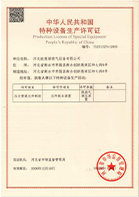
Dec . 10, 2024 14:18
Back to list
gas safety relief valve
The Importance of Gas Safety Relief Valves
Gas safety relief valves are critical components in various industries, including oil and gas, chemical manufacturing, and power generation. Their primary function is to protect equipment and personnel from excessive pressure, which could lead to hazardous situations, including explosions or equipment failure. Understanding the importance, functionality, and maintenance of these valves is essential for ensuring safe operations in any facility that handles gas.
What is a Gas Safety Relief Valve?
A gas safety relief valve is a type of pressure-relief device designed to release excess pressure from a system to prevent damage or catastrophic failures. These valves are usually spring-loaded and operate automatically. When the pressure within a system exceeds a predetermined limit, the valve opens, allowing gas to escape until the pressure falls within a safe range. This mechanism is crucial in maintaining operational integrity and safety.
Why Are Gas Safety Relief Valves Necessary?
1. Safety The primary purpose of gas safety relief valves is to prevent dangerous overpressure situations. In the absence of a functioning relief valve, pressure can build up to uncontrollable levels, potentially leading to explosions or equipment rupture. By providing a controlled outlet for excess gas, these valves play a vital role in protecting lives and property.
2. Regulatory Compliance Many industries are governed by strict safety regulations and standards. Safety relief valves are often mandated to comply with these regulations, ensuring that companies adhere to the required safety protocols. Non-compliance can result in significant fines, legal issues, and reputational damage.
gas safety relief valve

3. Operational Efficiency Beyond safety, gas safety relief valves contribute to the efficient operation of industrial systems. By preventing excessive pressure buildup, they help maintain optimal operating conditions, prolonging the life of equipment and reducing downtime due to maintenance or failures.
How Do Gas Safety Relief Valves Work?
Gas safety relief valves operate on a simple yet effective principle. Each valve is calibrated to open at a specific pressure level, usually referred to as the “set pressure.” When the pressure in the connected system reaches this set point, the force exerted by the internal gas overcomes the spring tension, causing the valve to open. As gas is released, the pressure within the system decreases, allowing the valve to close once the pressure returns to a safe level.
Maintenance and Inspection
Regular maintenance and inspection of gas safety relief valves are crucial for ensuring their reliable performance. Operators should adhere to recommended guidelines regarding the frequency of inspections, testing, and replacement of parts. During routine checks, technicians should examine the valve for leaks, corrosion, and proper functionality. It is essential to address any signs of wear or malfunction promptly to prevent potential failures.
Conclusion
Gas safety relief valves are indispensable for any operation that involves gas handling. Their role in maintaining safety, ensuring regulatory compliance, and promoting operational efficiency cannot be overstated. By understanding their functionality and keeping them well-maintained, industries can significantly reduce the risk of accidents and enhance overall safety. Investing in quality equipment and adhering to best practices for maintenance will not only protect personnel and assets but also contribute to a more productive and compliant workplace. As industries continue to evolve, the importance of gas safety relief valves will remain a cornerstone of safe operational practices.
Latest news
-
Safety Valve Spring-Loaded Design Overpressure ProtectionNewsJul.25,2025
-
Precision Voltage Regulator AC5 Accuracy Grade PerformanceNewsJul.25,2025
-
Natural Gas Pressure Regulating Skid Industrial Pipeline ApplicationsNewsJul.25,2025
-
Natural Gas Filter Stainless Steel Mesh Element DesignNewsJul.25,2025
-
Gas Pressure Regulator Valve Direct-Acting Spring-Loaded DesignNewsJul.25,2025
-
Decompression Equipment Multi-Stage Heat Exchange System DesignNewsJul.25,2025

